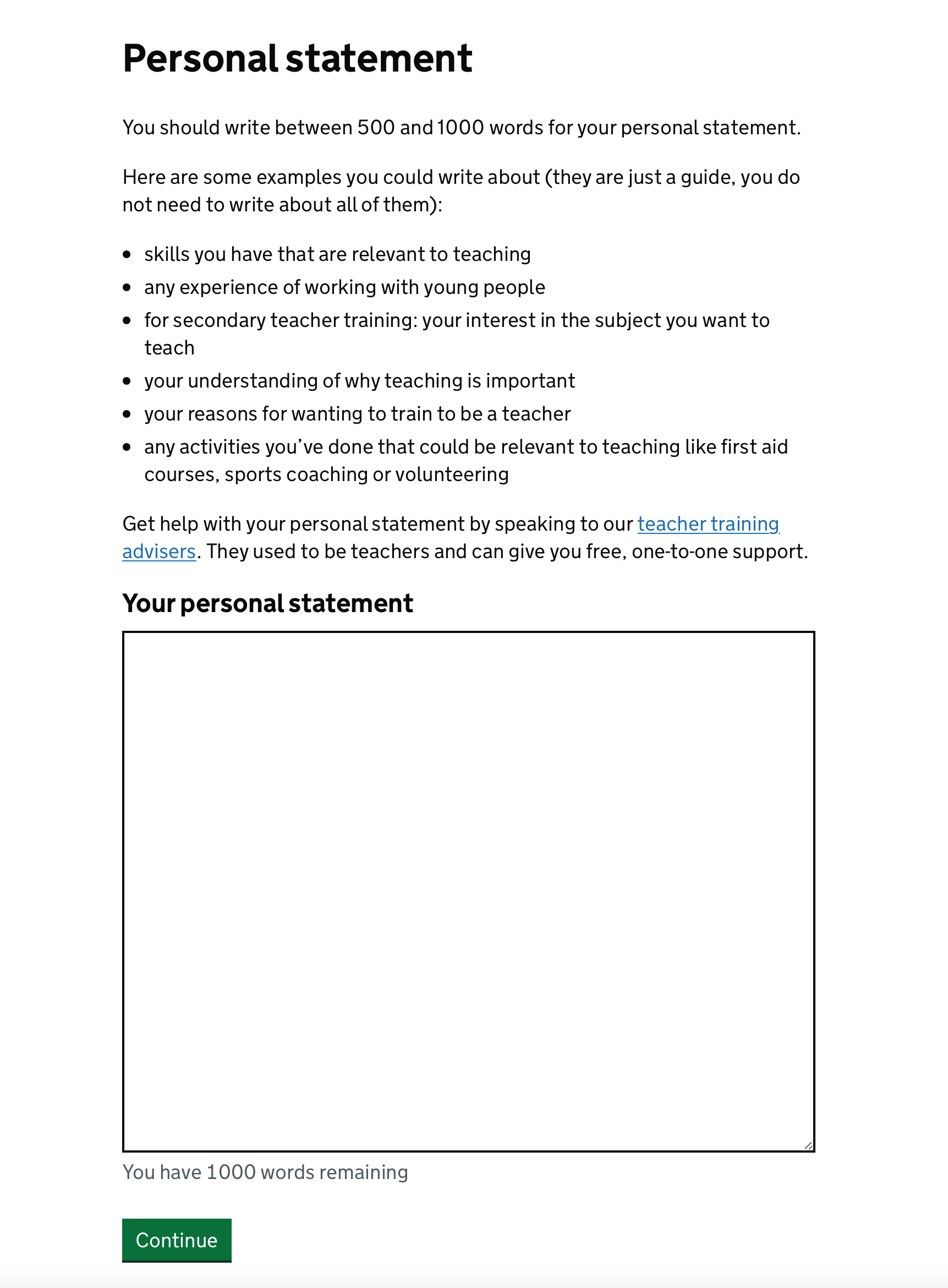
Previously, the personal statement had two sections on the application form: ‘Why you want to teach’ (600 words) and ‘Your suitability to teach a subject or age group’ (400 words).
We merged these personal statement sections into one, and improved the guidance around what we say to candidates to help them write a good personal statement.
We tested this design and improved the content shown to candidates after conducting research.
This change was made to all applications started after 9am on 24 April 2023. Applications started before then were unaffected.
The issue
Candidates found it difficult splitting up the experience and knowledge they have into separate questions and that there was a lot of overlap. Primary applicants had particular difficulty in answering separate questions, because ‘why you want to be a teacher’ and ‘why you want to teach Primary’ are very similar.
Candidates requesting that the personal statement be merged into one section was the 4th most common issue that arose as part of our candidate post-application feedback.
We wanted to test whether our new guidance aligned with what candidates expect to write about, and whether it was easy to read and comprehend the guidance.
We also wanted to learn more about how candidates would approach writing a personal statement, and what worries candidates about doing so. This will help determine what support we can give potential candidates in writing their personal statement.
‘Personal statement’ is one of the highest reasons for rejection used by providers. 20% of all application rejections this cycle have ‘personal statement’ marked as a reason for rejection. In merging the personal statement sections into one, there was scope for us to refine our guidance to help candidates improve the quality of their personal statement.
What we did
On the ‘personal statement’ page of the application form, we got rid of the ‘Why you want to teach’ and ‘Your suitability to teach a subject or age group’ sections, and replaced it with a single ‘personal statement’ page.
We moved the word count to the top, and added a recommended range of 500 to 1000 words.
We added a line to remind candidates that they don’t need to include every bullet point in the guidance.
We added multiple bullet points to help candidates understand what to write in their personal statement. This covers:
- their relevant skills, experience and activities
- their subject interest
- their understandings of why teaching is important
- their reasons for wanting to teach
- any relevant activities they’ve done relevant to teaching
We kept in the link to the teacher training advisers sign-up page, as candidates found this option very useful in research.

Releasing this change mid-cycle
Because we released this change in the middle of a recruitment cycle, we didn’t want it to disrupt any candidates who were midway through writing a personal statement using the previous 2 sections.
To avoid this, we only released the feature for new applications started on or after 3 April 2023.
If a candidate is unsuccessful with an application that used 2 personal statement sections and decided to apply again, they will see the new merged personal statement section. When this happens, we:
- mark the section as incomplete
- copy the previous 2 answers into the new single personal statement section, separated by a paragraph break
- show some content to explain what’s changed
What we learnt in research
We tested the design with 8 pre-application candidates at different stages of the consideration journey. We conducted two moderated content testing activities:
- presenting participants with snippets from a personal statement and asking them to write what they thought the information was describing
- showing participants the new guidance and inviting them to highlight where they thought the information was helpful, clear or confusing
We found that:
- there were no major usability or comprehension issues
- our word choices largely made sense
- the guidance met candidates’ expectations about what to write about
- no guidance was missing for candidates
- candidates were able to think of examples for almost all the bullet points
- most felt comfortable with the 1000 word limit
Users did make suggestions on where we could make the content clearer, or where they would struggle to follow the guidance.
We iterated the our initial design to:
- remove ‘rewards and challenges’ – candidates felt this was too difficult to answer before beginning to train to teach
- merge ‘interests and passions’ and ‘qualifications and courses’ into a single bullet point with some examples –candidates struggled to determine what was relevant to teaching in these instances.
- move ‘why you want to teach’ into the main bullet points
- include clarity around not having to address every bullet point – all users felt they would have to write something for every bullet point, which would make it harder for those who don’t have certain experiences or courses in knowing what to write.
- include a word count range of 500 to 1000
Candidates were comfortable with a single-style personal statement, as this meets their expectations for standard applications. Candidates see the personal statement as their chance to show their unique suitability to be a teacher, and so want to write about and prioritise different things.
Further considerations
We did not want to remove too much guidance mid-cycle for fairness. However, we should consider removing guidance around ‘understanding of education’ at a later stage, as candidates struggle to answer this at this stage in their teaching journey.
We have previously considered moving to many, smaller questions for a personal statement. Our research does not show a strong enough appetite for this structure to make this change yet. We need to conduct further research to investigate whether this would benefit candidates.